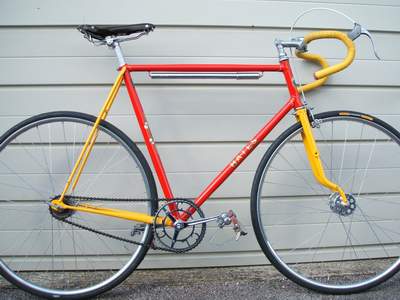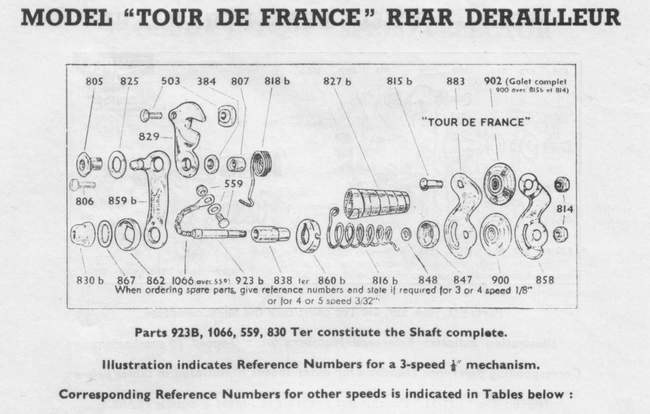Wheels for 1945-60s classic lightweights
Posted: Monday 21st September 2020
“Some years ago it suddenly dawned on this slow developer that the very easiest way to assemble a classic cycle was to first concentrate on matching the chosen frame to a date correct pair of suitable wheels. To that generation like myself (who spent many a happy hour with our noses pressed up to our local lightweight cycle shops windows) the equipment therein was etched forever in our memory. It has occurred to me that this knowledge cannot now be gotten as easily and that a few guiding words may well help my fellow enthusiasts. What I am intending with this listing is to give a guide as to what are the most suitable combinations bearing in mind what you are most likely to be able to source.
A. Wheel diameter.
It is my observation that of the frames that we find nowadays MOST of those built before 1950 are built for 26 x 1 ¼” wheels and MOST after were built for 27 x 1 ¼” wheels. I know that 27” wheels were introduced pre-war and am surprised regularly by finding frames built in the very late 1950’s that take 26” wheels. Whichever size they were built for there was invariably clearance for mudguards too. Very few frames were built without mudguard clearances and they would mostly have been pure track frames. These rare items can be identified by having no drillings for any brakes. An observation is that many of the frames built for 26” wheels are now being ridden with 27” wheels (or “sprints” or modern smaller wheels in them), these show a reduced mudguard clearance.
B. Rear dropout width.
Most frames are either 110, 115 or 120mm wide and this defines what you can do with gearing. Basically 110 is for a single speed machine, either free or fixed-wheel. 120 mm is perfect for five-speed freewheels which are freely available and suit most machines from our chosen era. 115 is best suited to 4-speed and the available choice of derailleur gears from the 1940’s might guide you towards using 4-speed even in a 120 frame too. Remember with a common Regina freewheel you can create a four speed 3/32” block by removing the smallest overhanging sprocket….. very easy!
Also remember that you can use one of the period Sturmey Archer hub gears, as these fit into a 110mmm wide frame this enables gearing to be easily used on a single-speed frame.
C. Choice of hubs.
Whilst there were many hubs available in times gone by some were fairly obscure (Powells, Shellwins, Coventry Ultralite etc) and some imported ones aren’t easy to find (i.e. Simplex). This is what you are likely to find:-
1. Airlite .Introduced in the mid 1930’s and the mainstay of the lightweight scene.
2. Postwar the large flange Airlite Continental was very popular. Most suitable for 1945-1965 era.
3. Bayliss & Wiley in both large and small-flange look very similar to Airlites.1945- 1960
4. Hardens. Most are drilled large flange with annular bearings. Available variations are a rarer small flange version, un-drilled large flange (now known as Bacon Slicers), most of these are single fixed but a rarer gear-sided only also turns up sometimes) Also the Harden Flyweight large flange only and with cup and cone bearings. These later are surprisingly available in two distinctive versions. 1946-1956
5. Blumfields. An alloy hub available in large and small flange. Have grease nipple in the centre of the barrel and quite attractive engraved makers marks. 1946-1959
6. FB and Gnutti (almost identical), small flange imported Italian hubs turn up, the large flange version is much rarer. Chrome barrel and alloy flanges. I can’t help wondering if Airlites are copies of the FB as this hub as this too was freely available before 1946-1965
7. Campag Gran Sport. Very similar to both of the above (were they all made by FB in the beginning, surely someone must know?). More easily available in both small and large flange. 1955-1962
Note. Of these hubs you have a better chance of finding Airlites and Campag in QR versions, the latter quite easily. Also, as more good English fixed hubs turn up than gear versions, remember that it is possible to convert fixed to gears but that it is more cost-effective to do two or three of them at the same time.
D. Choice of rims
1. Dunlop “Special Lightweight.” The most common sporting rim of the sporting cyclists. Chrome-plated steel and prone to rust. Warning, whilst re-plating is possible, acids tend to get trapped within the voids and rust re-appears too soon, should you be thinking of going this route why not keep the original rust instead of having later non-period rust? 1945-1965
2. Dunlop “Stainless Special Lightweight”. As above but rarer, the 40h rear is prone to cracking around the spoke holes, check carefully. 1946-1955
3. Dunlop alloy turn up occasionally and look very attractive. BEWARE. There is a very shallow well in these rims and getting a tyre on ( even a Dunlop) can be difficult. Getting one off after a puncture on a ride can be a nightmare. I know, it has happened to me. 1946- 1955
4. Weinmann Alesa. The most easy and economical option. Early ones from the early 1950’s have different engraved markings and no dimples around the spoke holes. The latter are a perfect choice and the former an acceptable one. 1950-1970
5. Constrictor (both the hollow Asp and the solid versions), this crescent shaped rim is the pretty choice of the era and this rider’s choice. Very tough but are never truly “true” as the riveted joining piece affects this. 1945- 1960
6. Alumite. A very attractive an unusual shaped rim that you might have a chance of finding. 1946-1955
7. Fiamme (Italian) and Mavic (French) sprints. Don’t forget sprints. Fiamme sprints have been on the British scene for a very long time. 1948-1965
8. Wood sprints. Most of what we find are French made America Fairbanks imported into Britain by (and marked) Constrictor.1945-1955
E. Spokes
Virtually all road wheels in Britain were 32 in the front wheel and 40 in the rear. Again most of what you will find in Britain will be 32/40. NOTE, classic wheels look good with 15/17 gauge spokes. If you want your classic lightweight to look as if it has moped wheels in it use common 14/16 spokes. This is the most common error in today’s restored machines. (I do know that thicker spokes were used in heavy touring machines and tandems and by those with a fuller figure etc)

F. Matching hubs with rims
The following is a personal opinion as to what goes better with what.
1. Small flange hubs look better in 26” wheels but if you must have large flanges the smaller “large” flange Blumfields look best. Also the small flange Powell hub has quite large “small” flanges but these are not an easily found choice.
Blumfields look superb matched with Alumite rims
Hardens look good matched with Constrictor rims.
FB, Gnutti and Campag work well with Fiamme / Mavic or Weinmann Alesa rims
Any of the English hubs go well with wood rims…but small flange is best.
2. Suggestions of poor matches
Campag, FB, Gnutti with Constrictor wood and alloy rims.
Hardens and Blumfield with Weinmann rims
Note. The dates here are only estimates as to when these rims were freely available. In the 1940’s there were serious shortages that improved towards the end of the decade.”
Alexander von Tutschek . Feb 06
It is traditional to build wheels 4x with 40 hole rims and 3x with 32 hole rims.
Posted: Monday 21st September 2020
Contents
This article appears in the following categories.
Upcoming Events
Whether you are looking for a gentle social meet up, or a 100-mile ride browse the community’s upcoming events and plan your next weekend outing.
